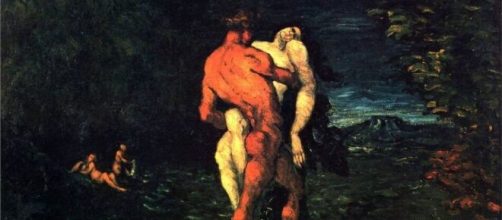Dissing an artist known as the father of modern art is a little like dishonoring a parent. But here goes. I think little of Paul Cézanne work. Coloring my gloomy take is a body of his work seldom mentioned. (More about that in a moment).
I wouldn’t have mentioned my lack of enthusiasm for Cézanne, but when England’s venerable Sunday newspaper The Observer calls Cézanne a “mesmerizing master of everyday mystery,” referring to a current Tate Modern “homage” to him, I couldn’t stay quiet.
The Observer art critic Laura Cumming believes Cézanne’s work is “simply summarize,” listing his themes apples and oranges, his wife and son, his gardener, the trees outside his studio, Mont Sainte-Victoire and bathers.
More than apples and oranges
But that’s not the sum of all his work. Cumming left out his rape and murder paintings, such as the menacingly sinister painting “The Abduction.” According to the owner of the work, Fitzwilliam Museum at Cambridge University, “themes of violence, eroticism and romantic fantasy are common in Cézanne’s work.” Cumming’s list is way short.
Maybe she was referring to the Tate Modern list, which British art critic Mark Hudson said in The Independent was “badly underrepresented” when it came to his rape and murder pictures. One of his melodramas was included, however, “The Murder” painted in 1870.
About “The Abduction,” it’s hard to overlook. What you see is a six-foot long scene of darkness with a harsh light thrown on a nude male hauling off the limp figure of a female nude.
Not an apple or orange here.
And while the subject of “The Abduction” is sometimes viewed in art circles as of Proserpine seized by Pluto in Ovid’s "Metamorphoses," Cézanne’s own words about women suggest it’s his thinking that drives this ghastly image, not Ovid’s.
Fear of women
Émile Zola mentions in his notes for his 1885 novel, "L’Oeuvre," that Cézanne was "afraid of women. He never brought girls back to his place [and] used to say 'they disturb my life too much. I don’t know what they’re for, and I’ve always been afraid to find out.'"
Is that what moved Cézanne to envision a man seizing a woman and carrying her off – because he was afraid to ask her out? And can that also be why he reduced the lap of the seated female in “Woman with Coffee Pot” to a triangle and her arms to cylinders – because of his fear?
Certainly, he made the female look less like flesh and blood.
Cézanne would probably disagree, point out that reducing subjects to geometric forms was his way of looking at the world. In letters to fellow painter Émile Bernard, he touted his way as the right way:
“May I repeat what I told you: Treat nature by basic geometric shapes – the cylinder, the sphere, the cone...” That was his idea of evoking nature and make the viewer feel it. And when he did this in his pictures of people, he claimed that he was interested in “bodies, not souls.”
So, to that end, he portrayed his wife Marie-Hortense Fiquet by reducing her head to a geometric form. Hudson said, “If it’s possible to detect a touch of tenderness in the set of her eyes and mouth, it’s certainly not something Cézanne himself was looking for.”
There you have it, why I’m not a fan of Cézanne. His stuff is, by his own admission, soulless.


